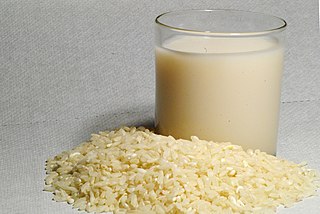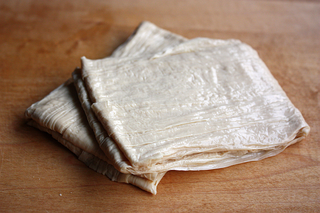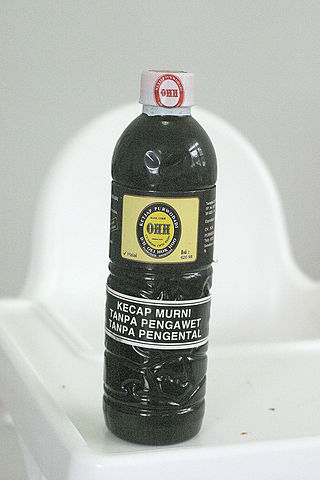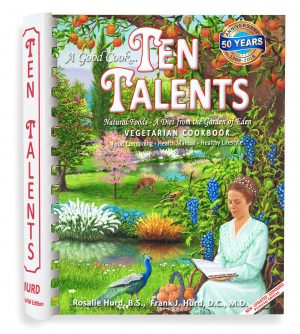
The soybean, soy bean, or soya bean is a species of legume native to East Asia, widely grown for its edible bean, which has numerous uses.

Kikkoman Corporation is a Japanese food manufacturer. Its main products and services include soy sauce, food seasoning and flavoring, mirin, shōchū, and sake, juice and other beverages, pharmaceuticals, and restaurant management services.

Soy milk, also known as soya milk or soymilk, is a plant-based drink produced by soaking and grinding soybeans, boiling the mixture, and filtering out remaining particulates. It is a stable emulsion of oil, water, and protein. Its original form is an intermediate product of the manufacture of tofu. Originating in China, it became a common beverage in Europe and North America in the latter half of the 20th century, especially as production techniques were developed to give it a taste and consistency more closely resembling that of dairy milk. Soy milk may be used as a substitute for dairy milk by individuals who are vegan or lactose intolerant.

Amazake is a traditional sweet, low-alcohol or non-alcoholic Japanese drink made from fermented rice. Amazake dates from the Kofun period, and it is mentioned in the Nihon Shoki. It is part of the family of traditional Japanese foods made using the koji mold Aspergillus oryzae, which also includes miso, soy sauce, and sake.

Rice milk is a plant milk made from rice. Commercial rice milk is typically manufactured using brown rice and brown rice syrup, and may be sweetened using sugar or sugar substitutes, and flavored by common ingredients, such as vanilla. It is commonly fortified with protein and micronutrients, such as vitamin B12, calcium, iron, or vitamin D.

Namagashi (生菓子) are a type of wagashi, which is a general term for traditional Japanese sweets and candies. Namagashi may contain fruit jellies, other gelatines such as Kanten, or sweetened bean paste. Namagashi is detailed, designed with using seasonal and natural motifs such as leaves and flowers to reflect the various objects of nature in Japan's four seasons. Namagashi are usually freshly made and are much more moist than other wagashi, like higashi. It generally contains 30% more water than other types. Like other wagashi, namagashi are made of natural ingredients; additives are rarely used. Namagashi is generally served with tea, and it's traditionally eaten on New Year's for good luck.

Tofu skin, Yuba, beancurd skin, beancurd sheet, or beancurd robes is a food product made from soybeans. During the boiling of soy milk, in an open shallow pan, a film or skin composed primarily of a soy protein-lipid complex forms on the liquid surface. The films are collected and dried into yellowish sheets known as tofu skin. Since tofu skin is not produced using a coagulant, it is not technically a proper tofu; however, it does have similar texture and flavor to some tofu products.

Okara, soy pulp, or tofu dregs is a pulp consisting of insoluble parts of the soybean that remain after pureed soybeans are filtered in the production of soy milk and tofu. It is generally white or yellowish in color. It is part of the traditional cuisines of Japan, Korea, and China. Since the 20th century, it has been used in the vegetarian cuisines of Western nations.

Soy protein is a protein that is isolated from soybean. It is made from soybean meal that has been dehulled and defatted. Dehulled and defatted soybeans are processed into three kinds of high protein commercial products: soy flour, concentrates, and isolates. Soy protein isolate has been used since 1959 in foods for its functional properties.

Kinako is roasted soybean flour, a product commonly used in Japanese cuisine. In English, it is usually called "roasted soy flour". More precisely it is "roasted whole soy flour". Usage of the word kinako appeared in cookbooks from the late Muromachi period (1336–1573). Kinako means "yellow flour" in Japanese.

Tofu is a food prepared by coagulating soy milk and then pressing the resulting curds into solid white blocks of varying softness: silken, soft, firm, extra firm. Tofu is also known as bean curd in English. Beyond these broad textural categories, there are many varieties of tofu. It has a subtle flavor, so it can be used in savory and sweet dishes. It is often seasoned or marinated to suit the dish and its flavors, and due to its spongy texture, it absorbs flavors well. It is a traditional component of East Asian and Southeast Asian cuisines, and has been consumed in China for over 2,000 years. In modern Western cooking, it is most often treated as a meat substitute.

Mildred Mathilda Lager was an American pioneer of natural foods and health food.
Danone North America is a consumer packaged food and beverage company based in White Plains, New York, U.S, that manufactures, markets, distributes, and sells branded premium dairy products, plant-based foods and beverages, coffee creamers, and organic produce throughout North America and Europe.

Sweet soy sauce is a sweetened aromatic soy sauce, originating in Indonesia, which has a darker color, a viscous syrupy consistency and a molasses-like flavor due to the generous addition of palm sugar or jaggery. Kecap manis is widely used with satay. It is similar to, though finer in flavor than, Chinese Tianmian sauce (tianmianjiang). It is by far the most popular type of soy sauce employed in Indonesian cuisine, and accounts for an estimated 90 percent of the nation's total soy sauce production.

Ten Talents is a vegetarian and vegan cookbook originally published in 1968 by Rosalie Hurd and Frank J. Hurd. At the time, it was one of the few resources for vegetarian and vegan cooks. The cookbook promotes Christian vegetarianism and a Bible-based diet, in keeping with teachings of the Seventh-day Adventist Church. By 1991, the 750-recipe cookbook was entering its 44th printing and had sold more than 250,000 copies. An expanded edition with more than 1,000 recipes was issued in 2012.

The Farm Vegetarian Cookbook is a vegan cookbook by Louise Hagler, first published in 1975. It was influential in introducing Americans to tofu, included recipes for making and using tempeh and other soy foods, and became a staple in vegetarian kitchens.

Harry Willis Miller was an American physician, thyroid surgeon and Seventh-day Adventist missionary. Miller was a vegetarian and pioneer in the development of soy milk.
William Roy Shurtleff also known as Bill Shurtleff is an American researcher and writer about soy foods. Shurtleff and his former wife Akiko Aoyagi have written and published consumer-oriented cookbooks, handbooks for small- and large-scale commercial production, histories, and bibliographies of various soy foods. These books introduced soy foods such as tofu, tempeh, and miso on a wide scale to non-Asian Westerners, and are largely responsible for the establishment of non-Asian soy food manufacturers in the West beginning in the late 1970s. In 1980, Lorna Sass wrote in The New York Times, "The two people most responsible for catapulting tofu from the wok into the frying pan are William Shurtleff and Akiko Aoyagi.” In 1995, Suzanne Hamlin wrote in The New York Times, “At the turn of the century there were two tofu suppliers in the United States. Today there are more than 200 tofu manufacturers...and tofu can be found in nearly every supermarket."
Akiko Aoyagi is an American cookbook author and artist. She is best known as the recipe developer, illustrator, and co-author of the soy-based cookbook series The Book of Tofu (1975), The Book of Miso (1976), and The Book of Tempeh (1979), that had a strong impact on the natural foods movement within the American counterculture.
















